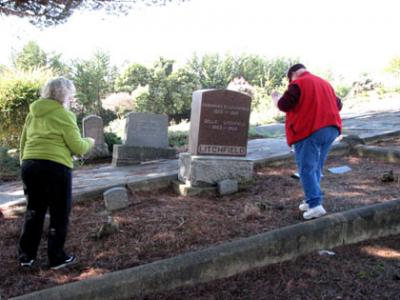
Road Trip, Part two: Cemetery Tour

My cousins Charlotte, Nancy, and I made a cemetery tour. My father and their mother were brother and sister, so we share grandparents and great-grandparents. Charlotte has become more intrigued by genealogy the last couple of years, and she wanted photos of family headstones to put up on the internet.
That’s why, on Valentine’s Day, we went to visit our ancestors, some of whom were gone before we were born, and some of whom we remember well.
Our great-grandparents, Chauncey and Belle Litchfield, are laid to rest in the Pioneer Cemetery in Watsonville, California. We went to see them first. They have a large pink granite marker, but they are buried off to one side under black headstones that say, "Mother" and "Father."
Chauncey and Belle’s son Ralph is buried in the plot. He died in an earthquake in Santa Barbara in 1925 at the age of 28. Apparently he ran outside, and was buried in bricks as the building’s facade collapsed. This is why you are not supposed to run outside in an earthquake. I don’t know why I bother repeating that rule. People always run outside. I always do. Ralph did.
Also laid to rest there is Asa, who was one of Ralph’s brothers. We all knew him as "Pop," and he died at the age of 81 in 1967. He was a buddy of my father’s, helping out with farm work, and going to Giants’ games up in San Francisco.
One night Pop had dinner at our house. He set out for his house, about a mile up the road. There was a thick fog that was hugging the ground, and Pop was a bit mellow with drink. An hour or so later he appeared at the kitchen door to report his car had gone off the road, and was stuck. My father and Pop got into my father’s truck, and my mother and I followed along behind in the car.
Sure enough, Pop had not quite negotiated a turn. The car had come to rest leaning sideways after taking out a post in the electric fence that ran along the side of the road. My father pulled in front of the car, and was attaching a tow chain, while Pop, my mother and I stood in back of it. Pop stepped back, and when he did his legs hit the top wire of the electric fence that was still standing, and he did a perfect cartoon windmill with his arms – woah, woah, WOAH - and fell over backward into the pasture. The man was almost 80, and my mother and I rushed to him, afraid he’d injured himself. When we got to him he looked up at us, smiled beatifically, and said, "I faw down, go boom."
Pop and my father went back to replace the fence post the next day.
Pop’s son Merle is buried in the family plot, right in front of the pink granite marker. He died in 1921 at the age of 11 or 12. I don’t know if it was illness or accident that took him.
My own parents, John and Juanita Litchfield, are buried about 40 feet away from the Litchfield family plot. My father’s marker describes him as a captain in the Army Air Force in World War II, but I remember him as a farmer, a guy in blue jeans and a dark green Penny’s work shirt, with a battered, stained fedora hat, and a crooked foolish grin.
My mother’s marker says she was a beloved wife and mother. It does not say she grew up in a Salvation Army orphanage in Texas, or that she was a gifted pianist, or a book keeper who kept track of all the farm’s accounts and payrolls, or that she was a right wing nut job.
We took pictures of headstones and sat in the sun remembering these relatives, especially the ones who had been around as we grew up. Strange to remember those living, breathing, laughing characters, and look at their headstones now. Then we headed off to the other cemetery to find more relatives, but we’ll talk about them next time.
- Login to post comments
